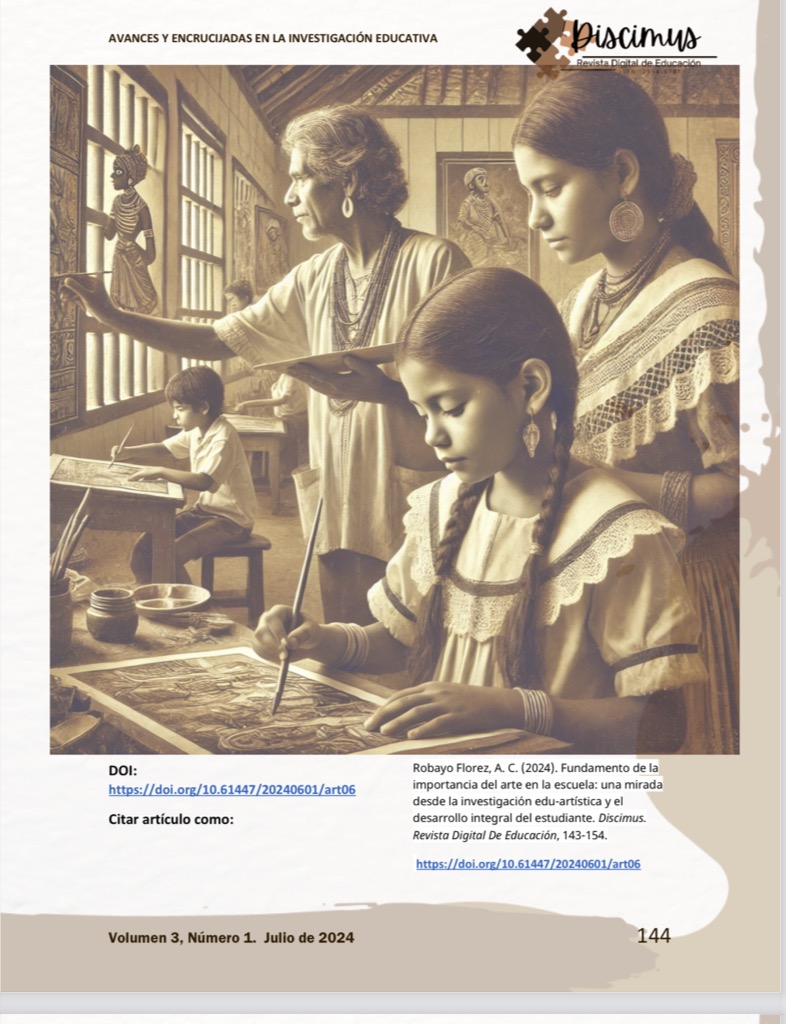The Foundation of Art's Importance in School: An Insight from Edu-Artistic Research and Student's Integral Development
DOI:
https://doi.org/10.61447/20240601/art06Keywords:
Art education, Aesthetic education, Future society, Core curriculumAbstract
For decades, educational-artistic research has yielded results demonstrating the importance of teaching and learning art within the school context. This article reaffirms the notion that art education is pivotal for the comprehensive development of students. Art education encompasses the teaching and learning of art without distinction between its various forms: musical, theatrical, plastic, or visual. Integrality denotes the balanced and complete development of students across all facets of life, encompassing not only academic prowess but also physical, emotional, social, and cultural dimensions, nurturing a spectrum of life skills.
Access to comprehensive education is a fundamental right, yet for it to be universally attainable, society must recognize and advocate for it as such. Understanding this integrality entails acknowledging arts education as essential and indispensable for the holistic development of individuals, particularly during their school years; without it, such holistic development would be incomplete. The aesthetic experience stands out as a unique element of arts education, setting it apart from other domains of knowledge. This distinctive quality fosters the holistic development of students, contributing to their personal growth and enabling them to thrive fully and satisfactorily in society.
In conclusion, this article underscores the imperative of shifting societal paradigms to facilitate a more meaningful integration of arts education into school curricula. It also encourages continued research efforts in the field of arts education.
Downloads
References
Abbs, P. (2004). A sense of art: The senses in art history and the art school. Berg.
Buendía Gutiérrez, B. . (2023). El payaso y la risa, un camino de aprendizajes sensibles: El uso del payaso. Discimus. Revista Digital De Educación, 2(1), 69-87. https://doi.org/10.61447/20220601/UMPv21006
Catalán, M. (2001). Una presentación de John Dewey. Daimon Revista Internacional de Filosofia, (22), 127-134.
Dewey, J., & Claramonte, J. (2008). El arte como experiencia. Paidós Ibérica. (Original work published 1934)
Eisner, E. W. (2015). Educar la visión artística (1a ed., 7a reimp.). Barcelona: Paidós. (Obra original publicada en 1995)
Eisner, E. W. (2002). La escuela que necesitamos: ensayos personales. Amorrortu.
Eisner, E. W. (2004). El arte y la creación de la mente: el papel de las artes visuales en la transformación de la conciencia. Barcelona: Paidós. (Original work published 2002)
Fiske, E. B. (1999). Arte y cognición: Integración de la teoría y la investigación con la práctica educativa. Teachers College Press.
Gardner, H. (1998). Educación artística y desarrollo humano.
Greene, M. (1995). Educando la visión democrática. Paidós.
Hernández, F., Jódar, A., & Marín Viadel, R. (1991). ¿Qué es la educación artística?. Sendai Editores.
Juanola Terradellas, R., & Masgrau Juanola, M. (2014). Las aportaciones de EW Eisner a la educación: un profesor paradigmático como docente, investigador y generador de políticas culturales. Revista española de pedagogía, 493-508.
Larrauri, M., & Max. (2012). La educación según John Dewey. Tàndem edicions.
León Calderón, H. W. (2022). La educación artística como objeto de estudio: una mirada desde la formación de formadores. Revista Conrado, 18(85), 470-481.
Mejía, M. R. (2010). Las pedagogías críticas en tiempos de capitalismo cognitivo. Aletheia, 2 (2).
Mora Muñoz, J. M., & Osses Bustingorry, S. (2012). Educación artística para la formación integral: Complementariedad entre cultura visual e identidad juvenil. Estudios pedagógicos (Valdivia), 38(2), 321-335.
Ortiz, C. M. M. (2014). Arte y experiencia estética: John Dewey. Nodo: Arquitectura. Ciudad. Medio Ambiente, 9(17), 95-105.
Roldán Ramírez, J. J. (2004). Educación estética, un enfoque fenomenológico-creativo centrado en las artes visuales. Análisis descriptivo-evaluativo en entornos escolares de Granada y Dakar (Doctoral dissertation, Universidad de Granada).
Tanner, D. E. (1994). Currículo de las artes visuales. Prentice Hall.
Winner, E., Goldstein, T. & Vincent-Lancrin, S. (2014). ¿El arte por el arte? La influencia de la educación artística: La influencia de la educación artística. OECD Publishing.

Downloads
Published
Issue
Section
License
Copyright (c) 2024 Andrea Carolina Robayo Florez (Autor/a)

This work is licensed under a Creative Commons Attribution-NonCommercial-ShareAlike 4.0 International License.
Open Access Policy at Discimus Journal
Discimus Journal is committed to the promotion of free circulation of scientific and academic knowledge, simultaneously ensuring appropriate acknowledgment for our authors while adhering to the ethical principles of scientific publishing. In alignment with this goal, Discimus publishes all its articles under the ATTRIBUTION-NONCOMMERCIAL-SHAREALIKE 4.0 INTERNATIONAL CC BY-NC-SA 4.0
What does this imply for authors, readers, and the scientific community?
1. Usage Freedom: Under the license CC BY-NC-SA 4.0, anyone is allowed to share (copy and redistribute the material in any medium or format) and adapt (remix, transform, and build upon the material) the articles published in Discimus, for any purpose, including commercially.
2. Attribution: Users must give appropriate credit, provide a link to the license, and indicate if changes were made to the original work. This credit must include the author's citation, the article title, the publication in Discimus, and, if feasible, the DOI of the article. This attribution should not in any way suggest that the authors or Discimus endorse the use made of the work.
3. Share Alik: If users remix, transform, or build upon the material, they must distribute their contributions under the identical license as the original.









